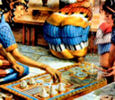Minoan and Eastern Mediterranean
Games and Game Boards
A History of Research
Niklas Hillbom (Department of Classical Studies, University of Lund, Sweden)
Opuscula Atheniensia, 25-26, 2000-2001, Pages 53-65
Note: With the author's permission, the text was scanned from a PDF file. The initial illustration of "The Minoan Gameboard" below did not appear with the original text, although all other illustrations are from the author's text. All footnotes have been retained. Moving the mouse cursor over a footnote numbered reference reveals the footnote in a separate Window. The Window disappears when the mouse cursor is moved away from the numbered reference. Each source page number appears in brackets before the text of that page. Because of the length of the paper, it has been divided into the sections that the author intended, and each section has been stored as a separate clickable Webpage.

ABSTRACT
As part of a larger study on Minoan games and game boards, this article presents the history of research on games, not only from prehistoric but also from other early civilizations around the Eastern Mediterranean.
From the middle of the 19th century, the accumulation of archaeological material, especially from Egypt, resulted first in articles and, somewhat later, in exhibitions and monographs on the subject. In the 1880s and 1890s, interest grew rapidly and archaeology was combined with the study of ancient authors and with anthropology. By the time of Evans' discovery of the royal game board at Knossos in 1901, a concept of ancient games and game boards was well established. From the very beginning, this was applied by Evans in discussing the Minoan games.
During the last fifty years, a few major works that cover "the games of the world" have been published, but most of the scholarly production has resulted in shorter articles. Interest in ancient games once again boomed in the last two decades of the century but did not, with very few exceptions, include any material from Crete. Furthermore, the achievement and writings of Evans could have been judged and carried on, but this never happened.
INTRODUCTION
(Page 53) I shall try to present how the knowledge of Minoan and other Eastern Mediterranean games and game boards has accumulated since the middle of the 19th century, as well as how the ways of discussing and presenting the material have changed. This will be done by summarizing the positions of knowledge in, approximately, the years 1900, 1950 and 2000.
1900: A View From The Dawn Of The Last Century, (Pages 53-56)
1950: Looking Back From The Middle of The 20th Century, (Pages 56-60)
2000: At The Year 2000 - The Last 50 Years and The Research Of Today, (Pages 60-64)
From these three vantage points, I shall look back at the research done in the preceding decades and try to imagine the inspiration and sources available to the scholars of the day.
A survey of research done in this area is greatly dependent upon how one defines the topic. The changing definitions, borders and limits are at the same time part of the very history of research itself. The approach here will be a broad one, involving all kinds of material that can in any possible way be connected with games.1 This includes game boards, draughtsmen, markers, dice, iconographic representations and so-called cup-holes. The Minoan material is in focus and is thoroughly examined, while that of the rest of the Aegean and the Eastern Mediterranean, as well as the material of later periods, is considered more briefly.
Acknowledgements
I am most grateful to Dr Sue Sherratt at the Ashmolean Museum in Oxford for her assistance and patience when I was studying Evans' and Mackenzie's notebooks. I also thank Mr. Sinclair Hood for his comments and suggestions regarding my work and on this text.
Abbreviations
The abbreviations of modem publications correspond to the bibliography at the end of the article. Abbreviations of ancient authors follow those listed in the Oxford Classical Dictionary. All other abbreviations follow the recommendation in AlA 104, 2000, 10-24, with one exception; ActaAth-4° = Skrifter utgivna av Svenska institutet i Athen.
Last update January 6, 2010
